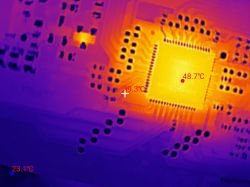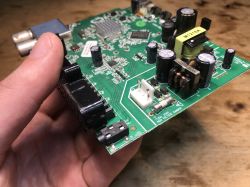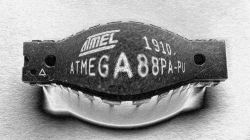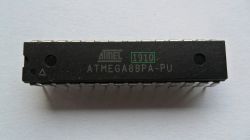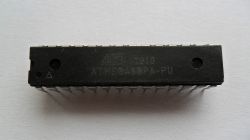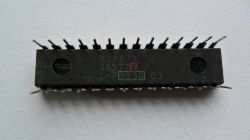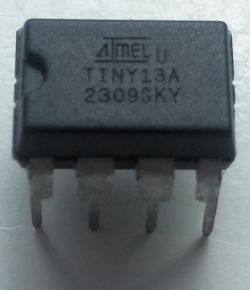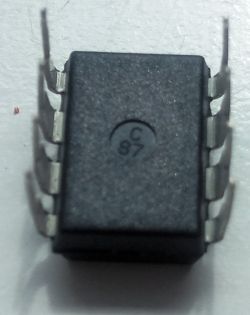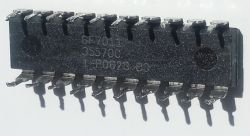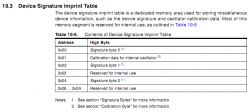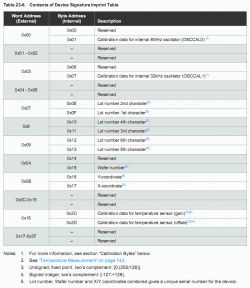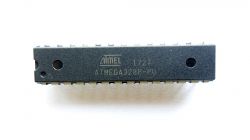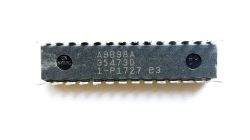While shopping on AliExpress, I noticed that a certain shop also has ATmega88PA-PU microcontrollers in DIP28 cases, so I ordered 2 pieces (price under 6 zł. per piece). After 8 days of dispatch, the package arrived. The writing on the microcontrollers looked quite good, but the signature read in the programmer no longer. One piece had two pins internally damaged and the signature could not be read at all - to be thrown away. The other one was used - it had the signature 0x1E930A correct for ATmega88(A/V), some program was uploaded and the fuse bits changed. Evidently a fake with the top of the case sanded down and new lettering applied, which had worn off when exposed to acetone. The original lettering is laser-engraved, so it is impossible to remove with acetone or any other solvent. Both pieces had identical dates ("1910" = week 10 of 2019) suggesting they came from a single production batch.
This also turned out to be a hoax after looking at the lettering on the bottom of the case, which was not forged (perhaps it needs too much work). The ATtiny/ATmega microcontrollers in the DIP cases, have a second production date (green box) and a letter on there to indicate the version/revision of the chip (red box). In the pieces ordered, these dates were different: "0936" (36th week of 2009) and "0808" (8th week of 2008).
At this point I knew that I had 1 working piece of the ATmega88/88A/88V. Now I wanted to find out which specific model I had. The ATmega88V model can be identified by the fact that it should not operate at clock frequencies above 10 MHz (e.g. with a 20 MHz quartz at supply voltage Vcc = 4.5-5.5V). If the microcontroller is operating at this frequency, two possibilities remain: ATmega88 or ATmega88A. The ATmega88A model can be recognised by the fact that it should operate at a clock frequency of 4 MHz and a supply voltage of Vcc = 1.8V (a normal ATmega88 should only operate from 2.7V). The second feature of the ATmega88A model is its lower current consumption, which, at 8 MHz and Vcc = 5.0V, is: about 5mA for the ATmega88 and about 4mA for the ATmega88A (the measurement conditions are described in the datasheet note, but in practice they are difficult to obtain and measure the current with such accuracy).
In summary, after testing, all indications are that I have the "D" version of the ATmega88A (it works at 4 MHz/1.8V - it flashes the LED, while, for example, the ATmega48-20PU does not work under such conditions). I have set up a dispute for a refund (I have attached pictures of the microcontroller, screenshots of the programmer and a description of the inconsistencies in the markings), which were received several hours later. I did not have to return the received chips. Despite the scam, I am still ahead by one "paint job", although it is not entirely clear whether it is fully operational.
Useful links:
http://romanworkshop.blutu.pl/avr/tips.htm - page with information about AVR microcontrollers (designations, parameters, signatures).
http://romanworkshop.blutu.pl/proj/avrdb.htm - program with basic information (parameters, signatures, default fuse bit values).
This also turned out to be a hoax after looking at the lettering on the bottom of the case, which was not forged (perhaps it needs too much work). The ATtiny/ATmega microcontrollers in the DIP cases, have a second production date (green box) and a letter on there to indicate the version/revision of the chip (red box). In the pieces ordered, these dates were different: "0936" (36th week of 2009) and "0808" (8th week of 2008).
At this point I knew that I had 1 working piece of the ATmega88/88A/88V. Now I wanted to find out which specific model I had. The ATmega88V model can be identified by the fact that it should not operate at clock frequencies above 10 MHz (e.g. with a 20 MHz quartz at supply voltage Vcc = 4.5-5.5V). If the microcontroller is operating at this frequency, two possibilities remain: ATmega88 or ATmega88A. The ATmega88A model can be recognised by the fact that it should operate at a clock frequency of 4 MHz and a supply voltage of Vcc = 1.8V (a normal ATmega88 should only operate from 2.7V). The second feature of the ATmega88A model is its lower current consumption, which, at 8 MHz and Vcc = 5.0V, is: about 5mA for the ATmega88 and about 4mA for the ATmega88A (the measurement conditions are described in the datasheet note, but in practice they are difficult to obtain and measure the current with such accuracy).
In summary, after testing, all indications are that I have the "D" version of the ATmega88A (it works at 4 MHz/1.8V - it flashes the LED, while, for example, the ATmega48-20PU does not work under such conditions). I have set up a dispute for a refund (I have attached pictures of the microcontroller, screenshots of the programmer and a description of the inconsistencies in the markings), which were received several hours later. I did not have to return the received chips. Despite the scam, I am still ahead by one "paint job", although it is not entirely clear whether it is fully operational.
Useful links:
http://romanworkshop.blutu.pl/avr/tips.htm - page with information about AVR microcontrollers (designations, parameters, signatures).
http://romanworkshop.blutu.pl/proj/avrdb.htm - program with basic information (parameters, signatures, default fuse bit values).
Cool? Ranking DIY Helpful post? Buy me a coffee.



